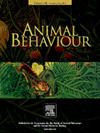Assortative mating at the innate immune locus TLR3 in song sparrows: opposites do not attract
IF 2.3
2区 生物学
Q2 BEHAVIORAL SCIENCES
引用次数: 0
Abstract
Parasites impose strong selection on the immune genes of their hosts. Much of what we know about the evolutionary ecology of immune genes comes from studies of the major histocompatibility complex (MHC), whose products recognize nonself-antigens and initiate an adaptive immune response. MHC loci are remarkably polymorphic, due in part to widespread nonrandom (generally disassortative) mating. At innate immune loci, however, it remains an open question whether nonrandom mating occurs and, if so, whether mating is assortative or disassortative. We sequenced wild-breeding song sparrows, Melospiza melodia, at part of the extracellular domain of Toll-like receptor 3 (TLR3), an innate immune locus that detects viral infection and varies geographically across song sparrow populations. Social mates were more similar at TLR3 than potential mates (i.e. cross-sex pairs of individuals not mated to one another). By contrast, social mates did not differ from potential mates in neutral-locus (microsatellite) genetic similarity. This is the first evidence, to our knowledge, that innate immune loci may be targets of nonrandom mating. Assortative mating at TLR3 could be adaptive if homozygotes have a fitness advantage, perhaps involving enhanced dimerization. We conclude that (1) nonrandom mating with respect to immune genotype is not restricted to genes of the MHC and (2) individual genetic variation at TLR3 in this population appears to be maintained despite, not because of, patterns of mate choice.
鸣禽先天免疫位点TLR3的分类交配:异性不相吸
寄生虫对宿主的免疫基因有很强的选择性。我们对免疫基因进化生态学的了解大多来自于对主要组织相容性复合体(MHC)的研究,MHC的产物识别非自身抗原并启动适应性免疫反应。MHC位点具有显著的多态性,部分原因是广泛存在的非随机(通常是非分类)交配。然而,在先天免疫位点上,非随机交配是否发生,如果发生,交配是选型还是非选型,这仍然是一个悬而未决的问题。我们对野生繁殖的鸣麻雀Melospiza melodia的toll样受体3 (TLR3)细胞外结构域的一部分进行了测序,TLR3是一种检测病毒感染的先天免疫位点,在不同的鸣麻雀种群中存在地理差异。在TLR3中,社会伴侣比潜在伴侣(即没有交配的异性个体)更相似。相比之下,社会配偶与潜在配偶在中性位点(微卫星)遗传相似性上没有差异。据我们所知,这是第一个证明先天免疫位点可能是非随机交配的目标的证据。如果纯合子具有适应性优势,TLR3的分类交配可能具有适应性,可能涉及增强的二聚体化。我们得出结论:(1)免疫基因型方面的非随机交配并不局限于MHC基因;(2)尽管配偶选择的模式不同,但该种群中TLR3的个体遗传变异似乎仍然存在。
本文章由计算机程序翻译,如有差异,请以英文原文为准。
求助全文
约1分钟内获得全文
求助全文
来源期刊

Animal Behaviour
生物-动物学
CiteScore
4.60
自引率
8.00%
发文量
236
审稿时长
10.2 weeks
期刊介绍:
Growing interest in behavioural biology and the international reputation of Animal Behaviour prompted an expansion to monthly publication in 1989. Animal Behaviour continues to be the journal of choice for biologists, ethologists, psychologists, physiologists, and veterinarians with an interest in the subject.
 求助内容:
求助内容: 应助结果提醒方式:
应助结果提醒方式:


